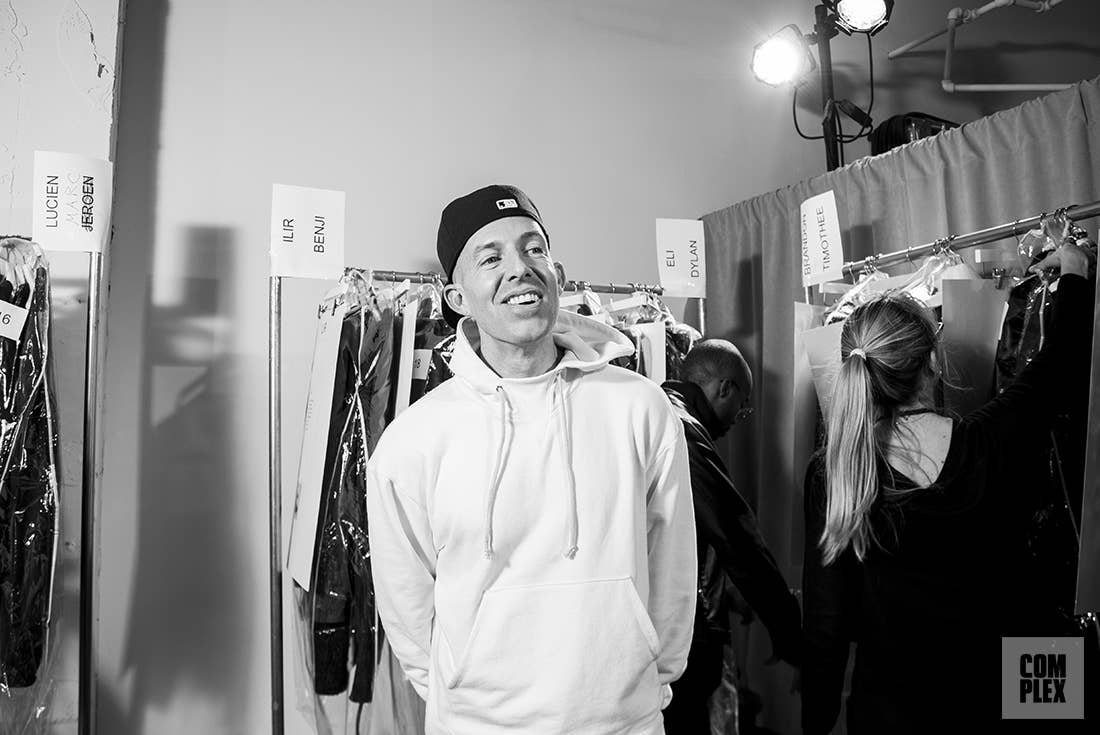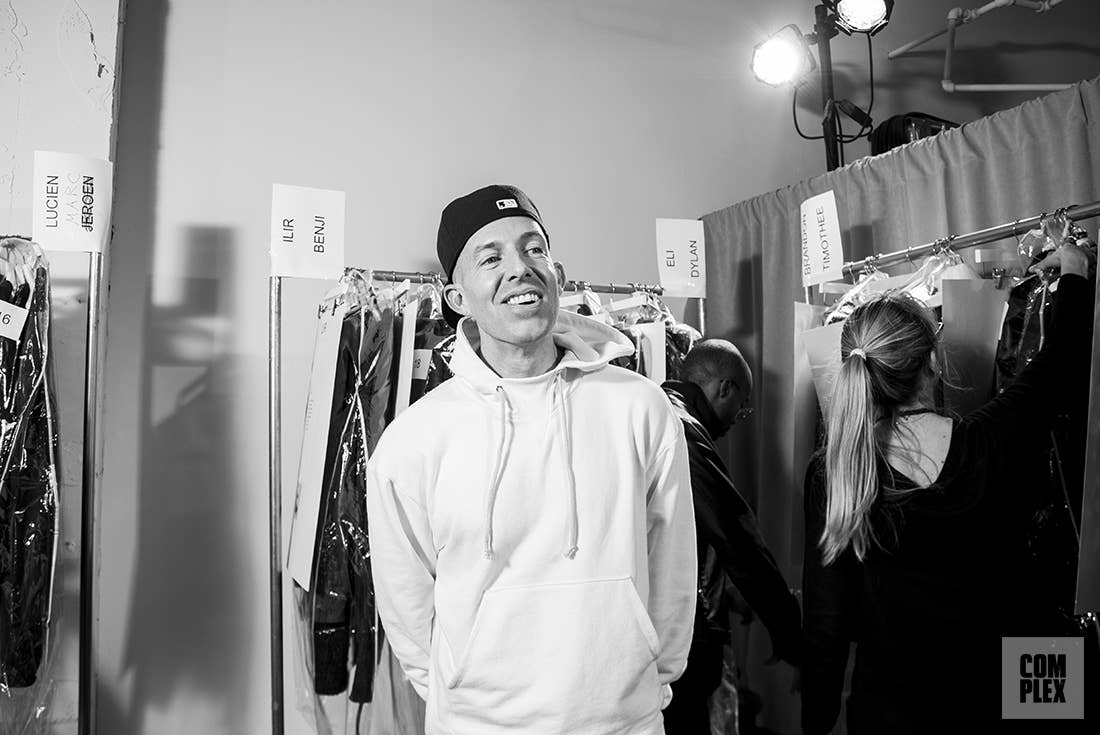
John Elliott can’t get a second to breathe.
Backstage after his Fall/Winter 2016 runway show at Skylight Clarkson Sq in downtown Manhattan, John Elliott is being yanked in all directions. The designer is dressed chicly in a white-on-white-on-white hoodie, jeans, and Nike Air More Uptempos fit, topped with a backwards navy blue baseball cap. Although he’s not as tall as any of the models he employs, his striking hazel eyes, sharp jawline, and uneven lips, crooked slightly to the right, cut through the crowd. A mob of reporters and editors swarm him for quotes; photographers try to grab his attention to steal a quick shot; friends, buyers, editors, and celebrities—including Kith’s Ronnie Fieg, the designer Rob Garcia, Joey Bada$$, and teenage It-model Luka Sabbat—greet him with exhilarated hugs. Everyone is here for him.
And not only here, today, but all week long. Timed with the tail end of New York’s second dedicated men’s Fashion Week (the concept was relaunched in July of 2015), Elliott’s show has loomed over the previous days’ proceedings. It’s been a beacon of hope, a light at the end of the tunnel, and everyone is nervously awaiting something, anything, exciting to happen.

“Overall, I think with everything that’s happened this season, some of the smaller, independent brands were the ones that people were looking forward to,” says Josh Peskowitz, an industry vet and co-founder of the soon-to-be-launched concept shop Magasin. “It’s a different way of dressing than is certainly put forth by some of the more traditional brands.”
It’s also a different way of putting on a fashion show. Compared to the production by designer Billy Reid in the same venue just the night before—during which a folk singer strummed sleepily on a guitar while models ambled down the runway—Elliott’s show, with a bass-heavy house soundtrack that could be felt as much as heard, and models who sped past flickering lights like they were navigating late night side streets, may as well have been beamed in from another planet. It’s Elliott’s third Fashion Week outing. His first, in February 2015, was a star-studded event, attended by Kanye West, Nick Young, Victor Cruz, and J.R. Smith, that earned him the mantle of a “designer to watch” byVogue, and coverage from all of the major men’s publications, from GQ and Esquire, to HighSnobiety and this magazine.

This show, however, marked another step forward in Elliott’s career. The atmosphere was electric and unmatched by anything else at Fashion Week, an infectious buzz of excitement that reverberated throughout the room, commanding the attention of jaded fashion types, hypebeasts, and guests of guests who crowded into the space. Downtown kids, uptown adults, and midtown suits were all held rapt.
“John Elliott has struck a nerve with a wide range of people because he has cracked the code to a very small sweet spot between street and luxury,” said fashion consultant Nick Wooster after the show. “His clothes are cool, but not too cool. Expensive looking, but not too expensive to buy.”
So how did Elliott, the sensei of sweatpants, become the only menswear designer who mattered this week?

Growing up in San Francisco in the early 1980s, Elliott, who had severe dyslexia, used art and fashion to express himself despite his struggles in school. At eight years old, he submitted his own sneaker designs to Nike. (Nike responded with a polite rejection.) He got his start in fashion at Villains, a clothing store on San Francisco’s iconic Haight Street, where he worked after graduating from college. From there, he was brought on as both manager and head buyer at Jack’s, also in The Golden Gate City, where he’d meet designer Simon Miller, who’d later help him create his first pair of denim jeans.
Elliott would spend the next few years building up Jack’s, before leaving his post at the shop and moving to L.A. for wholesale work. It was a rough start; he lived with his lifelong friend, Aaron Lavee, for a year, and sold his own clothes and shoes to save money for what later became John Elliott + Co. (He dropped the “+ Co.” from the name in December 2015.)
Eventually, Elliott and Lavee were able to cobble together $30,000—though even Elliott admits it was a tiny investment. “When we first started out, it was a real gamble, a real roll of the dice. But my best friend [Lavee] believed in me and we partnered up. We started with a really ambitious idea. To think we could start a company with such a small amount of money!” Elliott says, laughing.

For the next few years, he hustled. He began working with his college friend Garcia, and later, Miller, to learn the ins and outs of garment construction. After some crucial lessons about Japanese denim from Nobu Yamamoto of Fabric Brand, he designed his own denim. His big break came in Las Vegas in 2012 when he was on a trip with Garcia, who was presenting his En Noir collection to buyers, and was able to show his denim. As a result, he set up a meeting with Atrium in New York, currently one of Elliott’s stockists. John Elliott is now sold at 23 stores in the US and 16 shops worldwide. Since his first collection of menswear essentials officially launched in January 2013, he’s also been named one of GQ’s “Best Menswear Designers of America,” and his clothing has been co-signed by everyone from Pusha T to Scott Disick.
From the jump, the brand, according to Elliott, was all about the basics. “I had to start with T-shirts. I had to start with denim. I had to start with sweatshirts because if I started with something crazy, like say a leather hockey jersey, then it’s just a gimmick,” he says. “It won’t be accepted.” To him, it was more important to prove himself through something consumers actually needed. He wanted to design pieces that were wearable, but do it in new ways, whether that meant using a new fabric or adding zippers on the sides. “If I can make myself a part of your life and do something that you use every day then I might be able to hold your attention.”

The side-zippered hoodies, known as the Villain hoodie, have proven to be insanely popular. They’ve also proven to have incredible staying power, still moving enough units to be one of the brand’s top sellers, even after similar pieces, like one by Balmain, threatened to over expose the style. It’s the type of product men buy in every color. The Villain has become such a staple, that it’s now been knocked off by other brands and companies, which is, in a twisted way, a sign you’ve truly made an essential piece. “That just means that we had an idea that people accepted—and they wanted to try and tell that story, too.”
Elliott’s Baseline Sweatpants, Escobar Sweatpants, and Mercer Tees are among other top favorites noted by the retailers interviewed for this piece. “Those are all no-brainers,” says Aaron Cohen, founder of Michigan-based menswear store Revive, which started stocking John Elliott back in 2013.
Concepts buyer/designer/manager Deon Point agrees, and he’s hopped on a 6 a.m. train from Boston to make it to the show. He attributes Elliott’s success to his “ability to reinvent himself while still remaining true to his core.” Concepts, which began carrying the brand in-store in 2013, reportedly sells through their range within a few days.

Farfetch menswear buyer Reece Crisp says he isn’t surprised by the popularity of the sweats, tees, and hoodies. “He’s kind of made these the new basics, staples that every guy should have,” he explains. “It’s not as simple as it sounds, and John has been able to do it with ease. With the trend moving towards a cleaner canvas over the past few seasons, John has struck a cord and added a strong distinctive element of trend to basic menswear items that guys are loving.”
Over the years, John Elliott has expanded its catalogue, and the Fall/Winter 2016 collection, titled “Over the Line,” is a prime example. In addition to core items like the Villain hoodies and knits in a wool french terry, the collection includes elevated staples like a chalk flannel M65 jacket, a leather jacket made in collaboration with the Japanese artisans at Blackmeans, a Bolivia reversible full-zip jacket, and paneled oversized hoodie that utilizes sashiko stitching. “It’s taking elements of what we do and what we’re known for and trying to explore with it,” says Elliott. “It’s about trying something new and putting in new silhouettes.” New to the season is also John Elliott’s first foray into footwear—a low top that mixes canvas and suede, a high top with an upper made of leather and nubuck, and a combat boot.

“We believe he as a designer is on a mission to cover every aspect of men’s fashion,” says Revive’s Cohen. “He’s already found huge success providing men’s casual basics, which has allowed him to now move into footwear, denim, and outerwear. He’s able to reach every facet of a man’s wardrobe.”
“It’s reacting to what the marketplace wants, and it’s pushing it forward,” Peskowitz adds.
Still, even with the brand’s growth, Elliott continues to design wearable pieces that appeal to both menswear dudes and regular guys who just want cozy basics, a direct result of his days throwing parties in San Francisco, where he was exposed to diverse crowds every night. “I was able to see different things—people’s genders, what part of the city they were from, what they stood for, what they were doing with their lives, what they were doing with their careers. When I wanted to do this line, I really thought about that,” he says. “I thought about my friends, I thought about who I respect, and how cool I think it is to have a super diverse group of friends. So I wanted to build my collection for everyone. All-inclusive. It’s not for a specific guy.”

That inclusivity has helped John Elliott stand out in the sea of menswear brands, and this year, he’s poised to grow his fan base even further. Barneys, famous for bringing menswear brands like Off-White and Fear of God to the high-end shopper, placed an order for John Elliott’s Spring/Summer 2016 collection. “We’ve had an eye on the designer for some time and feel the timing is right to bring it to our clients’ attention,” Tom Kalenderian, the store’s Executive Vice President and Men’s General Merchandise Manager, says about the luxury retailer’s move. “We particularly appreciate and do well with California designers who have an independent approach and their finger on the pulse of what young men really want to wear.”
Back at Fashion Week, Elliott, who’s still greeting fans and well-wishers, never looks too overwhelmed by the mayhem. He’s feeling good. In just a little over two years, Elliott has captivated the menswear world. But right now, having wrapped the most anticipated show of the season, menswear’s new darling is just happy to be here. “I just feel lucky,” Elliott says when asked about his rapid-fire success. “I’m just appreciative of having the opportunity to have an idea, hopefully a challenging idea. It’s an honor that kids are accepting what we’re doing. Hopefully they want to keep paying attention.”
